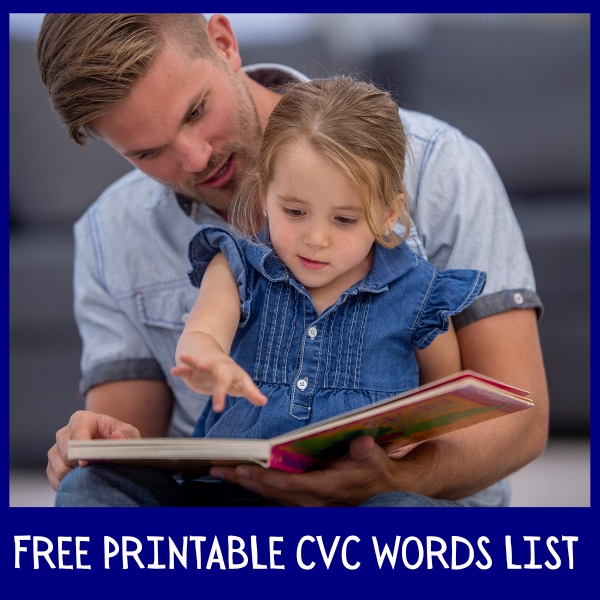
CVC Words List
CVC words are a fundamental part of early childhood education. These simple, three-letter words are made up of a consonant, a vowel, and another consonant, and are often some of the first words that children learn to read and write.
CVC words are an essential building block in developing phonemic awareness, which is the ability to identify and manipulate individual sounds within words. By mastering CVC words, children gain the foundational skills they need to read more complex words and sentences.
As well as this, they’re often high-frequency words (sight words) or at least make up part of them. As such, learning CVC words is an important step towards building a strong foundation in language and literacy skills.
Following is a CVC words list for all the Short A, Short E, Short I, Short O, and Short U sounds. It’s not a good idea to work on all of them with your child at once, break each group down, master them, and move onto the next sound.
After the CVC words list, we offer advice on what your child should know before they start learning CVC words, and different activities you can do to help speed up your child’s memorization of them.
You’ll find at the bottom a CVC words list pdf that you can download for free, so you don’t have to refer to your device every time you want to work on them.
Full CVC Words List
CVC Words for Short A
-ab: cab, dab, fab, gab, jab, lab, nab, tab
-ad: bad, dad, had, lad, mad, pad, sad, tad
-ag: bag, gag, hag, lag, nag, rag, sag, tag, wag
-am: bam, dam, ham, jam, ram, yam,
-an: ban, can, fan, man, pan, ran, tan, van
-ap: cap, gap, lap, map, nap, rap, sap, tap, yap, zap
-at: bat, cat, fat, hat, mat, pat, rat, sat, vat
Other: gal, pal, gas, yak, wax, tax
CVC Words for Short E
-ed: bed, fed, led, red, wed
-eg: beg, keg, leg, peg
-en: den, hen, men, pen, ten
-et: bet, get, jet, let, met, net, pet, set, vet, wet, yet
Other: yes, web, gem, hem, pep, step
CVC Words for Short I
-id: bid, did, hid, kid, lid, rid
-ig: big, dig, fig, gig, jig, pig, rig, wig, zig
-im: dim, him, rim
-in: bin, din, fin, pin, sin, tin, win
-ip: dip, hip, lip, nip, rip, sip, tip, zip
-it: bit, fit, hit, kit, lit, pit, sit, wit
Other: him, this, mix, six, fix
CVC Words for Short O
-ob: cob, gob, job, lob, mob, rob, sob
-og: bog, cog, dog, fog, hog, jog, log
-op: cop, hop, mop, pop, top
-ot: cot, dot, got, hot, jot, lot, not, pot, rot, tot
Other: box, fox, pox, rod, sod, mom
CVC Words for Short U
-ub: cub, hub, nub, rub, sub, tub
-ud: bud, cud, dud, mud
-ug: bug, dug, hug, jug, lug, mug, pug, rug, tug
-um: bum, gum, hum, mum, sum
-un: bun, fun, gun, nun, pun, run, sun
-ut: but, cut, gut, hut, jut, nut, rut
Other: pup, cup, bus
Before Your Child Learns CVC Words
Before children can learn CVC words, they should have already mastered certain foundational skills. These skills include a basic understanding of the alphabet and letter sounds, phonemic awareness, and the ability to blend and segment sounds.
Children should also be familiar with some sight words and have a solid grasp of basic vocabulary. Building these foundational skills will make it easier for children to learn and understand CVC words, and will help them as they progress to more complex reading and writing tasks.
At What Age Do Children Learn CVC Words?
Most children begin to learn CVC words by the time they’re six, depending on their individual development. As they become more familiar with letters and sounds, they will start to recognize common CVC word patterns and be able to sound out these words with increasing accuracy.
By the time they enter kindergarten or first grade, most children should be able to read and write basic CVC words. That said, it’s not uncommon for older children to not have mastered them as everyone develops differently, so if your child hasn’t mastered them, keep working with them.
How to Practice CVC Words with Your Child
There are many fun and engaging ways to practice CVC words with your child. One effective method is to use flip and reveal flashcards, where your child sees the word and you reveal the picture afterwards. This helps them associate the sound of the word with its corresponding image.
Another useful tool is picture posters, which show the picture and CVC word together, making it easy for your child to recognize and remember each word.
Additionally, reading books that use CVC words and pointing them out to your child can be a great way to reinforce these skills.
Whatever method you choose, it’s important for your child to read out the different sounds in the word. Get some flashcards with three dots under the words as this will help them isolate each sound.
And when you work with them ask them to spell out the different sounds. For example if you have a card with the word and picture ‘dog’. Tell them it’s a dog, and ask them back what it is, and they will tell you it’s a dog. Then ask your child to tell you the sounds, and they will tell you ‘d-o-g’.
This is an important step, especially when they first start working with CVC words, as they will begin to realise words are made up of smaller letter sounds. This is what’s known as phonemic awareness and will help your child’s learning.


